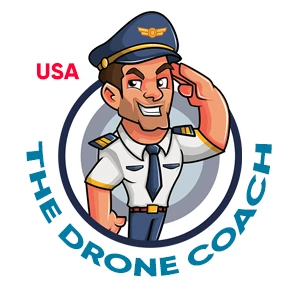Part 107 Drone Course Curriculum Video Lessons
Straightaway, our FAA part 107 drone course curriculum includes all of the material that will be covered in your part 107 exam test. Explicitly, our video lessons are visually appealing to make learning easier. More importantly, studies show that the brain forms new pathways when a task is repeated often. In turn, this will help students retain information longer.
1. Applicable sUAS Drone Regulations
Video Lesson: 46 Minutes
Important to realize, applicable sUAS regulations, definition of small unmanned aircraft systems, additional FAA part 107 requirements, foreign aircraft registration. In addition, rectification requirements, change of address, conditions for safe sUAS operation, reporting sUAS accidents, and remote pilot in command requirements. Also, visual observers, operating rules, restrictions of visual aids, drone operating limits, operations near aircraft and right of way. Finally, flights over or near non-involved people, waivers, situation awareness, advisory circulars, falsification of documents.
1.1 Nighttime Flying Operations
Video Lesson: 16 Minutes
Nighttime operations, human eye functions and anatomy, dark light environment adaptation, night blindness, use of red-filter light sources, nighttime scanning techniques, off-center viewing, field of vision, autokinesis, orientation, fixation, flicker vertigo, real-craft exterior aircraft lighting, and physiological conditions.
1.2 Operations Over Human Beings
This is a complex addition to the remote pilot studies and exam. Also known as Flying Over People or Flying Over Crowds of People, this lesson will review the four (4) categories and rules created under Part 107, which basically eliminates the need for typical operations to receive individual part 107 certificate of waivers from the FAA.
2. National Airspace Classifications
Video Lesson: 54 Minutes
Firstly, controlled and uncontrolled airspace, flight restrictions, FAA authorization class B, C, D, and E airspace, restricted airspace. Secondly, prohibited airspace, advisory circulars, Notice to Airmen, and airspace charts. Thirdly, this is one the most complex lessons that must be understood.
3. Aeronautical Sectional Charts
Video Lesson: 56 Minutes
Furthermore, this lesson further defines the previous airspace lesson. Notably, interpreting aeronautical sectional charts, airspace classes, and lower and upper shelves of airspace. In detail, when to use MSL or AGL, understanding various icons, victor airways, and airport data information. Lastly, longitude and latitude, deciphering elevation levels, more.
4. Aviation Weather And Its Effects On Drones
Video Lesson: 50 Minutes
Firstly, effects of weather, density altitude, wind shear, various clouds and how they affect drone flight. Secondly, temperature, pressure density, density altitude, convective currents, adiabatic heating and cooling, and temperature inversion. Lastly, atmospheric conditions, weather fronts, calculating cloud base, types of fog and how its formed.
5. Aviation Weather Sources
Video Lesson: 38 Minutes
Interpreting weather reports, aerodrome forecasts, interpreting meteorological reports, reading a METAR report, aviation forecasts, terminal aerodrome forecasts, METAR and TAF weather abbreviations, more. We provide one of the most comprehensive aviation weather lessons by making it easy to understand and remember.
6. Airport Operations
Video Lesson: 25 Minutes
Firstly, definitions of various airports, towered and non-towered airports, aircraft traffic patterns, sources for airport data, and runway markings. Secondly, signage relating to runway numbers and direction of runways, not the signs on the tarmac commercial pilots reference (no longer on the remote pilot exam). Thirdly, traffic patterns, downwind leg, approach patterns, pilot phraseology and the TSA. Lastly, reporting wildlife strikes, reading the chart supplements, and understanding rights-of-way.
7. Commercial and Private Pilot Radio Communications
Video Lesson: 21 Minutes
Important to realize, proper communication procedures, phraseology, advisory on airports without a control tower, advisory of airports with a daytime towner only, communication frequencies, aviation language, proper callout phraseology, aircraft call signs, more.
8. sUAS Performance and Loading
Video Lesson: 20 Minutes
The four forces of flight, sUAS loading, balance, stability, center of gravity, thrust, drag, lift, weight, maneuverability, load factor calculations, stalls and critical angle of attack, more. Remember that the FAA doesn’t know if you’re obtaining your remote pilot’s license just to photograph real estate or whether you plan to conduct agriculture crop spraying. Therefore, students are required to learn a lot to pass the exam.
9. Emergency Procedures And Flight Inspections
Video Lesson: 29 Minutes
Pre-flight checklists, in-air emergency procedures, maintenance and pre-flight inspections, flight hazards, guy wires, power plants, wingtip vortices, flying in the wire (near electromagnetic structures), proper battery storage, lost link emergency procedures, flyaways, more.
10. Crew Resource Management
Video Lesson: 29 Minutes
Another key point, aeronautical decision making, situational awareness, single pilot management, aeronautical decision making, and risk management. Furthermore, recognizing hazardous attitudes and antidotes, mitigating risk, and workload management.
11. Physiological Factors Affecting Pilot Performance
Video Lesson: 21 Minutes
Recognizing stress, fatigue, hyperventilation, heatstroke, dehydration, drugs, alcohol, more.
12. Course Review
Video Lesson: 17 Minutes
Video review lesson scrolling all of the definitions and phraseologies associated with part 107 remote pilot exam.

